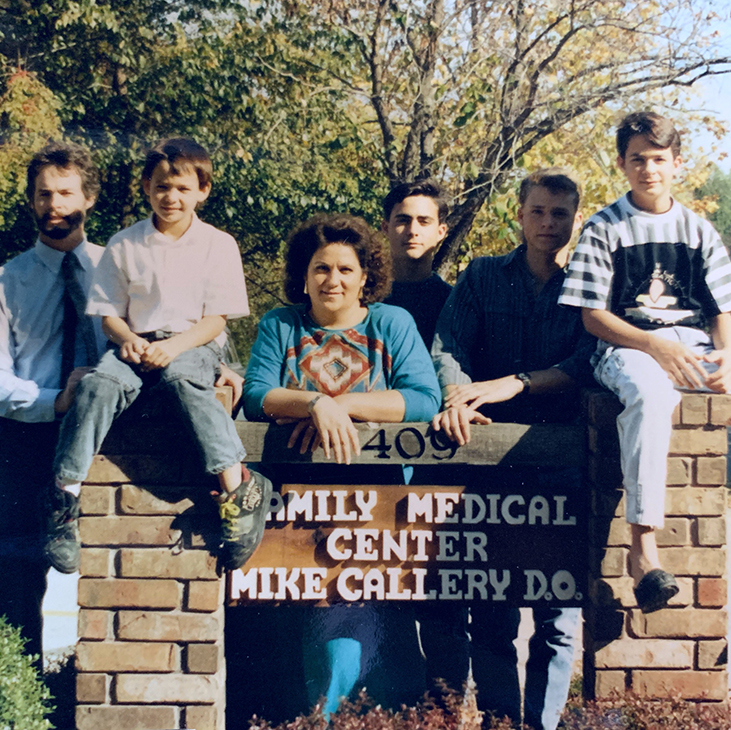
From architecture to medicine: A journey rooted in family legacy
Wednesday, October 16, 2024
Media Contact: Neile Jones | Communications Manager | 918-561-1169 | neile.jones@okstate.edu
Dr. Mark Callery’s path to becoming the medical director of population health at Utica Park Clinic is as deeply rooted in his family history as it is in his passion for helping others.
With a lineage of medical professionals dating back to his grandfather, a pioneer in osteopathic medicine, Callery's story is a testament to the enduring influence of family and the evolving nature of health care.
The family tradition of medicine began with Callery’s great-grandfather, a pharmacist in New York City, and continued with his grandfather, who became a physician in the 1930s.
“He moved from New York City to Kirksville, Missouri, where the first osteopathic medical school was located,” Callery said. “He practiced in Locust Grove, Oklahoma, for nearly 50 years doing everything from delivering babies to treating medical emergencies on his back porch.”
This tradition continued with Callery’s father, who was part of the first class at the Oklahoma College of Osteopathic Medicine. After completing his education, his father practiced emergency medicine in Poteau, Oklahoma, before taking over a family medicine practice in Sallisaw.
“He would work five days a week in the office and then work the ER in the small town a couple nights a week too,” he said. “He was always available, working long hours but still found time to be present at home. That blend of dedication to medicine and family left a lasting impression on me.”
Despite his family’s deep roots in medicine, Callery initially pursued a different path.
“I started college as an architecture major, but I soon realized it wasn’t what I was meant to do. Around that time, I felt a calling toward medicine, which aligned with my family’s legacy and my faith,” he said.
This shift led Callery to OSU Center for Health Sciences, where he completed his medical degree. Reflecting on his time there, he emphasized the importance of the supportive environment.
“The academic atmosphere was collaborative. We all helped each other, which made the challenging journey more manageable,” he said.



Today, Callery’s role at Utica Park Clinic extends beyond traditional patient care. As the medical director of population health, he is at the forefront of a relatively new approach in medicine.
“Population health helps primary care doctors offer high-quality care by addressing patients' needs beyond just the office visit. We employ social workers, nutritionists and other professionals to support patients and ensure they receive comprehensive care,” he said.
Callery’s work in population health is a continuation of the values his grandfather practiced decades ago.
“My grandfather embraced concepts like social determinants of health, which are central to value-based care today,” he said. “In many ways, I feel like I’m helping shape the future of primary care by making it more proactive and rewarding for both patients and doctors.”
Callery is a strong advocate for OSU-CHS and its role in shaping health care in Oklahoma.
“One of the biggest things is just that so many of the graduates come back to Oklahoma and practice here,” he said. “That’s what they advertise and that’s what’s true. A large number of my classmates are still practicing in Oklahoma and that’s a significant benefit for the state.”
“My grandfather embraced concepts like social determinants of health, which are central
to value-based care today. In many ways, I feel like I’m helping shape the future
of primary care by making it more proactive and rewarding for both patients and doctors.”
The connections fostered at OSU-CHS continue to benefit both the health care community and patients across Oklahoma.
“If I need somebody with a different specialty, there’s probably someone I graduated with who I can reach out to,” he said. “Having those connections makes a big difference and perpetuates over time.”
While medicine plays a significant role in Callery’s life, family remains a priority. With four children, including a daughter pursuing a Master of Business Administration at OSU, a son preparing for medical school, and high school twins recently accepted at OSU, the Callery family continues its tradition of education and service.
“Dinner table conversations can be interesting,” Callery said. “Three of us talk about medicine, while the other three would rather discuss anything else.”
Despite the demands of his career, Callery finds time for his family and personal interests, including playing guitar and golf.
“Golf is a stereotypical doctor’s answer, but it’s true,” he said. “It’s a great way to unwind and spend time with friends.”
Callery’s dedication to medicine extends beyond the clinic. He has participated in multiple medical missions, including trips to Paraguay, Ecuador and the Dominican Republic.
“These experiences remind me of the impact we can have when we provide care to those who need it most,” he said. “It’s also been a bonding experience with my son, who joined me on our most recent mission.”
As he continues to navigate the evolving landscape of health care, Callery remains committed to his roots and the values passed down through generations.
“Medicine is about helping people,” he said. “That’s what makes it all worth it.”
